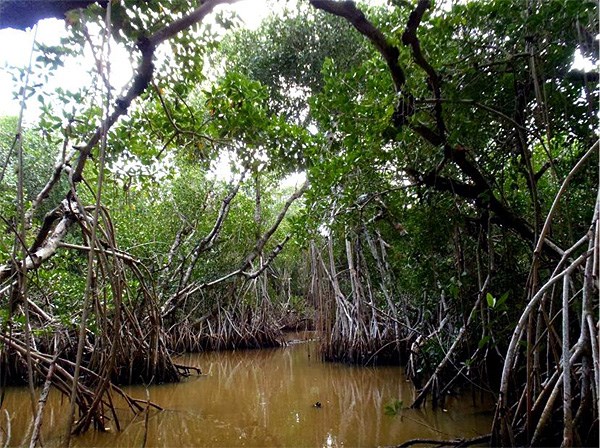
You will find these trees perched on the water's edge looking like they are about to make a great escape. Their arching, stilt-like branches appear to be walking the tree right out of the water. However, this tree is happy right where it is. It is adapted to its salty, wet environment and thrives in brackish water in soft muddy soil. These tangled "legs" are the prop roots of the tree that grow outward from the main trunk in all directions to help stabilize it in the shifting, soggy soil. For extra support the red mangrove also grows its roots from above. Areal roots that grow on the branches of these trees reach downward to the water for added support to remain secure in hurricanes. These areal roots also absorb and store gasses and nutrients inside of them because their roots are often submerged in water. Red mangrove trees also have special adaptations to help them reproduce in their soggy environment. They have small yellowish flowers with four petals and are pollinated by wind. Once they have been pollinated a seed called a propagule starts to grow in place of the flower. These trees are viviparous; their seeds will germinate while still attached to the tree instead of in the soil! Once the torpedo shaped propagule grows to about six inches it will fall from the tree into the water, where it will be carried by the tides to another location. These propagules have the ability to float; once they become heavy from being waterlogged the end of the seed which will sprout roots starts to sink so that it can reach the soil. Once the seed gets stuck in the soil it will begin rooting in that location. Red mangroves are important to the survival of many creatures that live at Big Cypress. This estuarine environment is a favorite of many marine creatures, mammals and birds that depend on the red mangrove for survival. Leaves fall from the tree year round which provides the basis of the food chain. Many fish and shell fish, such as the grouper and stone crab begin their lives among the roots of the red mangroves, which serves as a nursery by protecting them from predators. Many wading birds such as the great blue heron and great egret also enjoy the safety the roots provide by using the red mangroves as a nesting and breeding ground. The tall, arching roots protect and stabilize the shoreline by trapping mud and sediment that gradually builds up over time. This help to protect the shoreline from erosion. The destruction and removal of the mangrove estuary causes shoreline erosion and endangers the creatures that depend on it for safety and survival. We also benefit from the health of the mangrove estuary - approximately 90 percent of the commercially harvested fish in Florida depend on this wetland habitat for survival. Come to Big Cypress National Preserve to take a breathtaking canoe ride through a red mangrove tunnel and witness the beauty and impact of these stunning trees. |
Last updated: May 5, 2020
